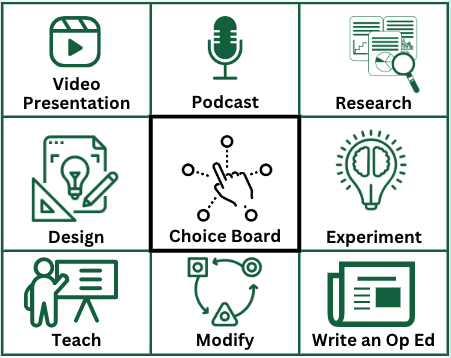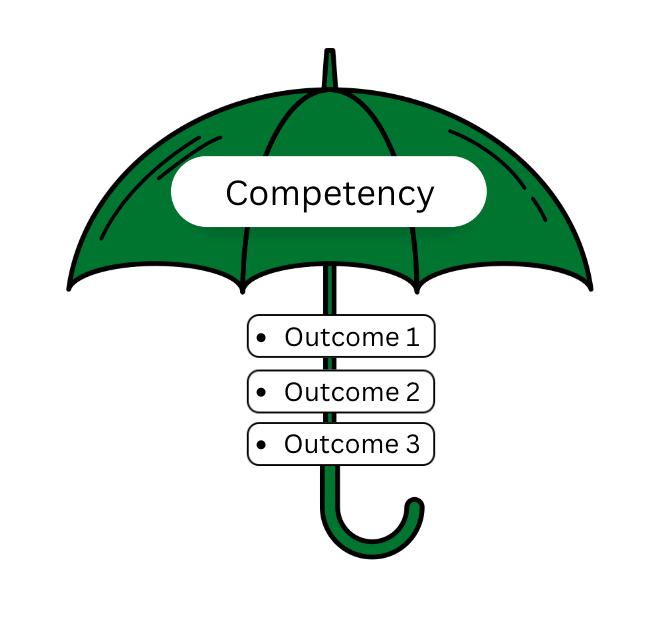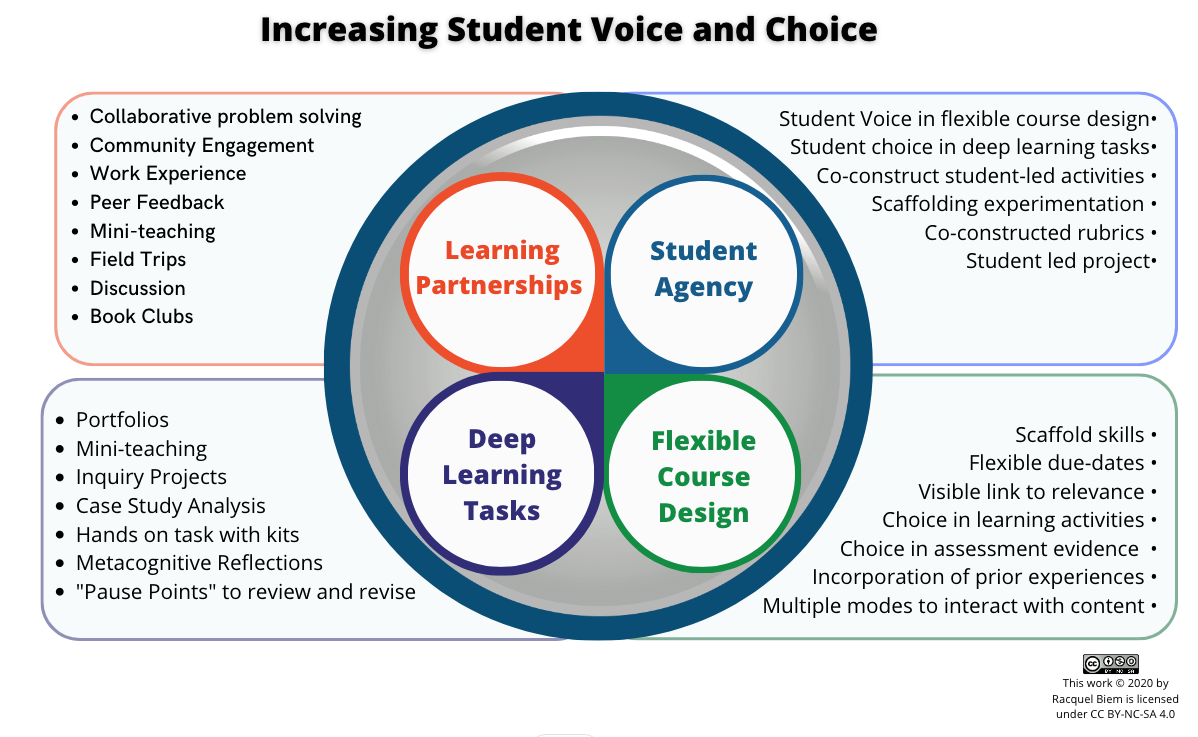Instructional / Course Design
-
Writing Learning Outcomes using Generative AI
We know that learning outcomes are essential for orienting students, articulating them can be an arduous process. Where does one even begin? Thankfully, this is one area where Generative AI’s capabilities to support teaching really deliver. Using a text-producing AI tool such as the USask created tool ALDA (AI Learning Design Assistant), insert as many details about your course and the desired output as possible. Here is a sample prompt that you might submit to AI to produce course-level learning outcomes: Please create 6 learning outcomes that consider the following parameters. This is a university course at the [ordinal] year level of a [discipline] program. The course title is: “[Course…
- Assessment and Evaluation, Curriculum Development, Inclusivity, Instructional / Course Design, Uncategorized, Wellness
Maximizing Learning Potential with Student Wellness
Your Brain on Teaching and Learning: Series 2 Are your students showing signs of anxiety? Are your students experiencing a sense of purpose and engagement in the classroom? ______________________________________________________________________________________________ The impact of teaching and learning practices on student wellness cannot be overstated ______________________________________________________________________________________________ By integrating insights from brain science, we can create powerful learning environments that prioritize student wellness. Let’s explore three ways to associate your teaching practices with student wellbeing: Alignment for Clarity: Alignment refers to the process of strategically planning your learning outcomes to clearly define what your students will be able to do, know, or value. Then, intentionally plan how you will assess and teach based on…
- Curriculum Development, Educational Theory, Experiential Learning, Instructional / Course Design, Instructional Strategies, Uncategorized, Wellness
From Stuck to Supercharged: The What and Why of Brain Plasticity
Your Brain on Teaching and Learning: Series One What is Brain Plasticity? Brain plasticity is the brain’s ability to reorganize and restructure itself throughout a person’s lifetime. It is a result of the brain’s ability to form new neural connections and strengthen existing ones based on the activities we engage in and the information we process. Factors such as learning, exercise, diet, and environmental stimuli can all influence brain plasticity. Recent research has shown that educators who understand the basics of brain plasticity can design courses that promote and accelerate learning and retention. Why is Brain Plasticity Important? Brain plasticity offers several benefits in the field of education, including: Improving…
- Curriculum Development, Educational Theory, Experiential Learning, General, Instructional / Course Design, Instructional Strategies, Wellness
Your Brain on Experiential Learning
“Is disengaged.” “Is easily distracted.” “Shows no interest.” “Never shows up.” No professor wants to use these phrases to describe their students, but disengagement is a persistent problem — making descriptions such as these all too common today. Experiential Learning can help. Experiential learning is a powerful educational approach that helps students remain focused as it promotes active learning, fosters creativity and innovation, and prepares students for the real world. Let me explain: Experiential learning engages multiple parts of the brain simultaneously When learners participate and apply their learning in authentic contexts, it activates different areas of the brain responsible for sensory processing, motor skills, and cognitive functions, such as…
-
Syllabus Generator Offers Ease and Support When Creating Your Syllabi
A course syllabus provides students with a guide to what they should be able to do by the end of the course and a plan for how they will get there. This includes requirements and expectations but also signals the type of course it will be through information on assessments, learning strategies, required resources, and even the instructor profile. While the University of Saskatchewan has had a recommended syllabus template for several years, it was an MS Word document that allowed instructors to fill in information but provided little guidance around effective wording to provide students with clarity and instructors with the ability to set the tone they were hoping…
-
Student Voice and Choice: Co-Creating Choice Boards
Summary: Co-creating a list of potential assessments with students is a great opportunity to increase student voice and choice. Students who choose assessments that are personally relevant are more likely to be motivated, engaged, and take ownership of their learning. Giving students a choice and voice in assessments allows them to demonstrate their understanding of the material in ways that are meaningful to them. Date of publishing: February 23, 2023 Choice Boards A choice board is a is a grid or chart that provides students with a set of options to meet learning outcomes. Choice boards can be used in many ways, depending on the goals and outcomes in the course.…
- Assessment and Evaluation, Curriculum Development, Experiential Learning, Instructional / Course Design, Uncategorized
Time for a Jump Start? Teaching and Learning Fund at the GMCTL
Feeling stuck? Even though good ideas for change are exciting and energizing, sometimes they sit still or do not progress. Common reasons include: Working at it sporadically or “off the side of your desk” Attending to more urgent or pressing issues Being at (or beyond) your limit in terms of projects and things to do Uncertainty about next steps, or seeing the next steps as daunting Questioning if this is really what you’re supposed to be doing, anyway If the time has come for an infusion of help and your project is about one or more of the following Program-level curriculum change (see the 4-step process for successful change) Assessment improvement across…
-
Defining Competencies and Outcomes
Summary: Improve your course clarity with competencies and outcomes. Learn how to break down complex skills into measurable parts for better student understanding and success. Date of publishing: January 16, 2023 Defining Competencies and Outcomes Although there is no widely accepted distinction between a competency and an outcome, there is sufficient commonality for the following working definition to be used to improve the structure and clarity of courses and programs. A competency is an overarching capability the learner can do. Examples include critical thinking, problem solving, effective communication, design functions, or physical performative skills. Since a competency is generally too complex to measure on its own, it must be broken…
-
Increasing Voice and Choice in the Classroom
Summary: Boost engagement in your classroom! Discover strategies to amplify student voice and choice, making learning more personalized and empowering for all. Date of publishing: December 21, 2022 When we think of increasing voice and choice in the classroom we may immediately think of choice in assignments or assessment tasks. Whereas these do increase student choice, these alone do not get to the heart of increasing student voice and seeing students as partners in the teaching and learning process. It is for this reason that supporting student voice and choice requires building a learning environment focused on partnerships, student agency, flexible learning paths, and deep learning tasks. The learning framework…
-
Announcing a New OER – Universal Design for Learning (UDL): One Small Step
We know that learners bring a wide range of knowledge, skills, backgrounds, and experiences into the classroom. As educators, we can expect to find variability in our classroom. The USask Learning Charter lists, as one of the Educator Commitments and Responsibilities, to Strive for Excellence in Teaching. This commitment means that educators work to develop respectful and inclusive learning environments that support student learning. Honouring this commitment requires that educators co-create with students a shared space for learning in which all participants feel respected, valued, and empowered to contribute as they achieve their goals and share the gifts of their identities in relationship with one another. This approach is also part of…



